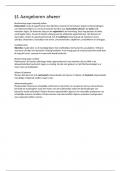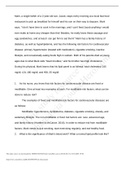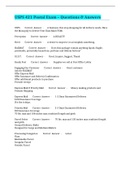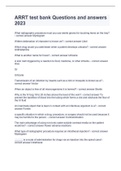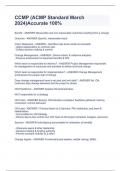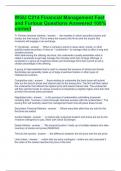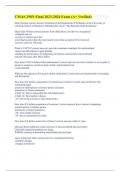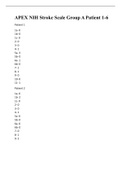Package deal
EMT Emergency Care 14th Edition bundles
EMT Emergency Care 14th Edition bundles
[Show more]EMT Emergency Care 14th Edition bundles
[Show more]Blunt-force trauma - ANSWER-- injury caused by a blow that DOES NOT penetrate the skin or other body tissue. Danger zone - ANSWER-area around wreckage of a vehicle collision or other incident where special safety precautions should be taken. Index of suspicion - ANSWER-awareness that there may b...
Preview 2 out of 7 pages
Add to cartBlunt-force trauma - ANSWER-- injury caused by a blow that DOES NOT penetrate the skin or other body tissue. Danger zone - ANSWER-area around wreckage of a vehicle collision or other incident where special safety precautions should be taken. Index of suspicion - ANSWER-awareness that there may b...
911 system - ANSWER-a system for telephone access to report emergencies. A dispatcher takes the information and alerts EMS or the fire or police department as needed. Enhanced 911 also identifies the caller's phone number and location automatically. abandonment - ANSWER-leaving a patient after ...
Preview 2 out of 9 pages
Add to cart911 system - ANSWER-a system for telephone access to report emergencies. A dispatcher takes the information and alerts EMS or the fire or police department as needed. Enhanced 911 also identifies the caller's phone number and location automatically. abandonment - ANSWER-leaving a patient after ...
1x sold
Arterial bleeding - ANSWER-Bleeding from an artery, which is characterized by bright red blood that is rapid, profuse, and difficult to control capillary bleeding - ANSWER-bleeding from capillaries, which is characterized by a slow, oozing flow of blood cardiogenic shock - ANSWER-Shock, or lack ...
Preview 3 out of 25 pages
Add to cartArterial bleeding - ANSWER-Bleeding from an artery, which is characterized by bright red blood that is rapid, profuse, and difficult to control capillary bleeding - ANSWER-bleeding from capillaries, which is characterized by a slow, oozing flow of blood cardiogenic shock - ANSWER-Shock, or lack ...
Evidence-Based Techniques Techniques or practices that are supported by scientific evidence of their safety and efficacy, rather than merely on supposition and tradition. Medical Direction Oversight of the patient-care aspects of an EMS system by the Medical Director Medical Director A physici...
Preview 4 out of 35 pages
Add to cartEvidence-Based Techniques Techniques or practices that are supported by scientific evidence of their safety and efficacy, rather than merely on supposition and tradition. Medical Direction Oversight of the patient-care aspects of an EMS system by the Medical Director Medical Director A physici...
Evidence-based techniques - ANSWER-lists of steps, such as assessments and interventions, to be taken in different situations. Protocols are developed by the Medical Director of an EMS system Medical direction - ANSWER-Oversight of the patient care aspects of an ems system by the medical directo...
Preview 2 out of 6 pages
Add to cartEvidence-based techniques - ANSWER-lists of steps, such as assessments and interventions, to be taken in different situations. Protocols are developed by the Medical Director of an EMS system Medical direction - ANSWER-Oversight of the patient care aspects of an ems system by the medical directo...
1x sold
Evidence-based techniques Techniques or practices that are supported by scientific evidence of their safety and efficacy rather than merely by supposition and tradition. Medical direction Oversight of the patient care aspects of an ems system by the medical director. Direction can be either off...
Preview 4 out of 31 pages
Add to cartEvidence-based techniques Techniques or practices that are supported by scientific evidence of their safety and efficacy rather than merely by supposition and tradition. Medical direction Oversight of the patient care aspects of an ems system by the medical director. Direction can be either off...
Chief Complaint (C/C) - ANSWER-Statement (usually in the patient's own words) that describes the symptoms or concern associated with the primary problem the patient is having. The reason why the patient calls EMS Closed-ended Question - ANSWER-A question requiring only a "yes" or "no" answer...
Preview 1 out of 2 pages
Add to cartChief Complaint (C/C) - ANSWER-Statement (usually in the patient's own words) that describes the symptoms or concern associated with the primary problem the patient is having. The reason why the patient calls EMS Closed-ended Question - ANSWER-A question requiring only a "yes" or "no" answer...
Arterial bleeding - ANSWER-Bleeding from an artery, which is characterized by bright red blood that is rapid, profuse, and difficult to control capillary bleeding - ANSWER-bleeding from capillaries, which is characterized by a slow, oozing flow of blood cardiogenic shock - ANSWER-Shock, or lack ...
Preview 1 out of 2 pages
Add to cartArterial bleeding - ANSWER-Bleeding from an artery, which is characterized by bright red blood that is rapid, profuse, and difficult to control capillary bleeding - ANSWER-bleeding from capillaries, which is characterized by a slow, oozing flow of blood cardiogenic shock - ANSWER-Shock, or lack ...
Arterial bleeding - ANSWER-Bleeding from an artery, which is characterized by bright red blood that is rapid, profuse, and difficult to control capillary bleeding - ANSWER-bleeding from capillaries, which is characterized by a slow, oozing flow of blood cardiogenic shock - ANSWER-Shock, or lack ...
Preview 1 out of 2 pages
Add to cartArterial bleeding - ANSWER-Bleeding from an artery, which is characterized by bright red blood that is rapid, profuse, and difficult to control capillary bleeding - ANSWER-bleeding from capillaries, which is characterized by a slow, oozing flow of blood cardiogenic shock - ANSWER-Shock, or lack ...
past medical history information gathered regarding the patient's health problems in the past if you are unable to talk to the patient try to obtain history from family members, bystanders, medications present, and observations open-ended question requiring more than just a yes or no answer ...
Preview 1 out of 4 pages
Add to cartpast medical history information gathered regarding the patient's health problems in the past if you are unable to talk to the patient try to obtain history from family members, bystanders, medications present, and observations open-ended question requiring more than just a yes or no answer ...
Alveolar ventilation - ANSWER-the amount of air that reaches the alveoli artificial ventilation - ANSWER-Forcing air or oxygen into the lungs when a patient has stopped breathing or has inadequate breathing. Also called positive pressure ventilation. automatic transport ventilator (ATV) - ANSWER...
Preview 1 out of 3 pages
Add to cartAlveolar ventilation - ANSWER-the amount of air that reaches the alveoli artificial ventilation - ANSWER-Forcing air or oxygen into the lungs when a patient has stopped breathing or has inadequate breathing. Also called positive pressure ventilation. automatic transport ventilator (ATV) - ANSWER...
Evidence-based techniques - ANSWER-Techniques or practices that are supported by scientific evidence of their safety and efficacy rather than merely by supposition and tradition. Medical direction - ANSWER-Oversight of the patient care aspects of an ems system by the medical director. Direction ...
Preview 3 out of 18 pages
Add to cartEvidence-based techniques - ANSWER-Techniques or practices that are supported by scientific evidence of their safety and efficacy rather than merely by supposition and tradition. Medical direction - ANSWER-Oversight of the patient care aspects of an ems system by the medical director. Direction ...
agonal breathing - ANSWER-irregular, gasping breaths that precede apnea and death apnea - ANSWER-no breathing asphyxial cardiac arrest - ANSWER-a cardiac arrest caused by systemic hypoxia, typically due to a respiratory disorder asystole - ANSWER-A condition in which the heart has ceased generat...
Preview 1 out of 2 pages
Add to cartagonal breathing - ANSWER-irregular, gasping breaths that precede apnea and death apnea - ANSWER-no breathing asphyxial cardiac arrest - ANSWER-a cardiac arrest caused by systemic hypoxia, typically due to a respiratory disorder asystole - ANSWER-A condition in which the heart has ceased generat...
Contamination - ANSWER-The introduction of dangerous chemicals, disease, or infectious materials. CISM or Critical incident stress management - ANSWER-A comprehensive system that includes education and resources to both prevent stress and deal with stress appropriately when it occurs. decontami...
Preview 1 out of 1 pages
Add to cartContamination - ANSWER-The introduction of dangerous chemicals, disease, or infectious materials. CISM or Critical incident stress management - ANSWER-A comprehensive system that includes education and resources to both prevent stress and deal with stress appropriately when it occurs. decontami...
A-B-C's - ANSWER-airway, breathing, circulation AVPU - ANSWER-a memory aid for classifying a patient's level of responsiveness or mental status. The letters stand for alert, verbal response, painful response, unresponsive chief complaint - ANSWER-in emergency medicine, the reason EMS was calle...
Preview 1 out of 1 pages
Add to cartA-B-C's - ANSWER-airway, breathing, circulation AVPU - ANSWER-a memory aid for classifying a patient's level of responsiveness or mental status. The letters stand for alert, verbal response, painful response, unresponsive chief complaint - ANSWER-in emergency medicine, the reason EMS was calle...
Pharynx - ANSWER-Throat; divided into 3 Sections Airway - ANSWER-The passageway by which air enters and leaves your body Oropharynx - ANSWER-Where The area of the mouth or oral cavity joins the pharynx Nasopharynx - ANSWER-Where the nasal passages empty into the pharynx Laryngopharynx - ANSWER-T...
Preview 2 out of 7 pages
Add to cartPharynx - ANSWER-Throat; divided into 3 Sections Airway - ANSWER-The passageway by which air enters and leaves your body Oropharynx - ANSWER-Where The area of the mouth or oral cavity joins the pharynx Nasopharynx - ANSWER-Where the nasal passages empty into the pharynx Laryngopharynx - ANSWER-T...
aerobic metabolism - ANSWER-The cellular process in which oxygen is used to metabolize glucose. Energy is produced in an efficient manner with minimal waste products. anaerobic metabolism - ANSWER-The metabolism that takes place in the absence of oxygen; the principle product is lactic acid. ca...
Preview 1 out of 2 pages
Add to cartaerobic metabolism - ANSWER-The cellular process in which oxygen is used to metabolize glucose. Energy is produced in an efficient manner with minimal waste products. anaerobic metabolism - ANSWER-The metabolism that takes place in the absence of oxygen; the principle product is lactic acid. ca...
Abandonment - ANSWER-Leaving a patient after care has been initiated and before the patient has been transferred to someone with equal or greater medical training. advance directive - ANSWER-A legal document designed to indicate a person's wishes regarding care in case of a terminal illness or d...
Preview 1 out of 3 pages
Add to cartAbandonment - ANSWER-Leaving a patient after care has been initiated and before the patient has been transferred to someone with equal or greater medical training. advance directive - ANSWER-A legal document designed to indicate a person's wishes regarding care in case of a terminal illness or d...
acetabulum - ANSWER-the pelvic socket into which the ball at the proximal end of the femur fits to form the hip joint acromioclavicular joint - ANSWER-the joint where the acromion and the clavicle meet acromion process - ANSWER-the highest portion of the shoulder alveoli - ANSWER-the microscopic...
Preview 2 out of 9 pages
Add to cartacetabulum - ANSWER-the pelvic socket into which the ball at the proximal end of the femur fits to form the hip joint acromioclavicular joint - ANSWER-the joint where the acromion and the clavicle meet acromion process - ANSWER-the highest portion of the shoulder alveoli - ANSWER-the microscopic...
Contamination - ANSWER-The introduction of dangerous chemicals, disease, or infectious materials. CISM or Critical incident stress management - ANSWER-A comprehensive system that includes education and resources to both prevent stress and deal with stress appropriately when it occurs. decontami...
Preview 2 out of 6 pages
Add to cartContamination - ANSWER-The introduction of dangerous chemicals, disease, or infectious materials. CISM or Critical incident stress management - ANSWER-A comprehensive system that includes education and resources to both prevent stress and deal with stress appropriately when it occurs. decontami...
Contact with or presence on material that is present or does not belong and that is somehow hard for the person's, animals, environment - ANSWER-Contamination The movement of a substance through a surface or on a molecular level, thru intact materials; penetration or spreading - ANSWER-Permeatio...
Preview 2 out of 7 pages
Add to cartContact with or presence on material that is present or does not belong and that is somehow hard for the person's, animals, environment - ANSWER-Contamination The movement of a substance through a surface or on a molecular level, thru intact materials; penetration or spreading - ANSWER-Permeatio...
Evidence-based techniques - ANSWER-Techniques or practices that are supported by scientific evidence of their safety and efficacy rather than merely by supposition and tradition. Medical direction - ANSWER-Oversight of the patient care aspects of an ems system by the medical director. Direction ...
Preview 1 out of 2 pages
Add to cartEvidence-based techniques - ANSWER-Techniques or practices that are supported by scientific evidence of their safety and efficacy rather than merely by supposition and tradition. Medical direction - ANSWER-Oversight of the patient care aspects of an ems system by the medical director. Direction ...
Having to do with patients who are significantly overweight or obese bariatric A method of lifting and carrying a patient from ground level to a structure in which two or more rescuers kneel, curl the patient to their chest stand then reverse the process to lower the patient to the stretcher di...
Preview 2 out of 8 pages
Add to cartHaving to do with patients who are significantly overweight or obese bariatric A method of lifting and carrying a patient from ground level to a structure in which two or more rescuers kneel, curl the patient to their chest stand then reverse the process to lower the patient to the stretcher di...
Emergency Care 14th Edition Chapter 23 allergen - answer-something that causes and allergic reaction allergic reaction - answer-an exaggerated immune response anaphylaxis - answer-a severe or life-threatening allergic reaction in which the blood vessels dilate, causing a drop in blood pressure, ...
Preview 1 out of 1 pages
Add to cartEmergency Care 14th Edition Chapter 23 allergen - answer-something that causes and allergic reaction allergic reaction - answer-an exaggerated immune response anaphylaxis - answer-a severe or life-threatening allergic reaction in which the blood vessels dilate, causing a drop in blood pressure, ...
Blunt force trauma - ANSWER-injury caused by a blow that does not penetrate the skin or other body tissues danger zone - ANSWER-the area around the wreckage of a vehicle collision or other incident within which special safety precautions should be taken index of suspicion - ANSWER-awareness that...
Preview 1 out of 1 pages
Add to cartBlunt force trauma - ANSWER-injury caused by a blow that does not penetrate the skin or other body tissues danger zone - ANSWER-the area around the wreckage of a vehicle collision or other incident within which special safety precautions should be taken index of suspicion - ANSWER-awareness that...
Aura - ANSWER-a sensation experienced by a seizure patient right before the seizure, which might be a smell, sound, or general feeling diabetes mellitus - ANSWER-also called "sugar diabetes" or just "diabetes," the condition brought about by decreased insulin production or the inability of th...
Preview 1 out of 2 pages
Add to cartAura - ANSWER-a sensation experienced by a seizure patient right before the seizure, which might be a smell, sound, or general feeling diabetes mellitus - ANSWER-also called "sugar diabetes" or just "diabetes," the condition brought about by decreased insulin production or the inability of th...
Emergency Care Chapter 4 13th Edition By Daniel Limmer & Michael F. O'Keefe scope of practice - ANSWER-a set of regulations and ethical considerations that define the scope, or extent and limits, of the EMT's job consent - ANSWER-permission from the patient for care or other action by the EMT...
Preview 2 out of 5 pages
Add to cartEmergency Care Chapter 4 13th Edition By Daniel Limmer & Michael F. O'Keefe scope of practice - ANSWER-a set of regulations and ethical considerations that define the scope, or extent and limits, of the EMT's job consent - ANSWER-permission from the patient for care or other action by the EMT...
Changes pressure within the chest cavity - ANSWER-To move air, the respiratory system... Negative; Positive - ANSWER-___________ Pressure is used to move air in and ___________ pressure is used to move air out. Inspiration - ANSWER-Also known as Inhalation Expiration - ANSWER-Also known as exha...
Preview 1 out of 3 pages
Add to cartChanges pressure within the chest cavity - ANSWER-To move air, the respiratory system... Negative; Positive - ANSWER-___________ Pressure is used to move air in and ___________ pressure is used to move air out. Inspiration - ANSWER-Also known as Inhalation Expiration - ANSWER-Also known as exha...
absorbed poisons - ANSWER-poisons that are taken into the body through unbroken skin activated charcoal - ANSWER-a substance that absorbs many poisons and prevents them from being absorbed by the body antidote - ANSWER-a substance that will neutralize the poison or its effects delirium tremens ...
Preview 1 out of 2 pages
Add to cartabsorbed poisons - ANSWER-poisons that are taken into the body through unbroken skin activated charcoal - ANSWER-a substance that absorbs many poisons and prevents them from being absorbed by the body antidote - ANSWER-a substance that will neutralize the poison or its effects delirium tremens ...
topographic anatomy - ANSWER-The superficial landmarks of the body that serve as guides to the structures that lie beneath them. anatomic position - ANSWER-This is a position of reference in which the patient stands facing you, arms at the side, with the palms of the hands forward. coronal plane...
Preview 3 out of 22 pages
Add to carttopographic anatomy - ANSWER-The superficial landmarks of the body that serve as guides to the structures that lie beneath them. anatomic position - ANSWER-This is a position of reference in which the patient stands facing you, arms at the side, with the palms of the hands forward. coronal plane...
A system for telephone access to report emergencies 911 system A process of continuous self review of all aspects of an EMS system for the purpose of identifying and correcting aspects of the system that require improvement Quality improvement Oversight of the patient-care aspects of an EMS sy...
Preview 2 out of 10 pages
Add to cartA system for telephone access to report emergencies 911 system A process of continuous self review of all aspects of an EMS system for the purpose of identifying and correcting aspects of the system that require improvement Quality improvement Oversight of the patient-care aspects of an EMS sy...
bariatric - ANSWER-having to do with patients who are significantly overweight or obese body mechanics - ANSWER-the proper use of the body to facilitate lifting and moving and prevent injury direct carry - ANSWER-a method of transferring a patient from bed to stretcher, during which two or more...
Preview 1 out of 1 pages
Add to cartbariatric - ANSWER-having to do with patients who are significantly overweight or obese body mechanics - ANSWER-the proper use of the body to facilitate lifting and moving and prevent injury direct carry - ANSWER-a method of transferring a patient from bed to stretcher, during which two or more...
Which of the following is TRUE about respiratory anatomy in infants and children? v B.The nose of an infant is proportionally larger than that of an adult. C.Infants and children rely less on the diaphragm to breathe than adults do. D.The ribs are less pliable in infants than in adults. - ANSWE...
Preview 1 out of 2 pages
Add to cartWhich of the following is TRUE about respiratory anatomy in infants and children? v B.The nose of an infant is proportionally larger than that of an adult. C.Infants and children rely less on the diaphragm to breathe than adults do. D.The ribs are less pliable in infants than in adults. - ANSWE...
bariatric - ANSWER-having to do with patients who are significantly overweight or obese body mechanics - ANSWER-the proper use of the body to facilitate lifting and moving and prevent injury direct carry - ANSWER-a method of transferring a patient from bed to stretcher, during which two or more...
Preview 2 out of 5 pages
Add to cartbariatric - ANSWER-having to do with patients who are significantly overweight or obese body mechanics - ANSWER-the proper use of the body to facilitate lifting and moving and prevent injury direct carry - ANSWER-a method of transferring a patient from bed to stretcher, during which two or more...
When lifting, the emergency medical technician (EMT) should keep the weight of the object as A. close to the body as possible. B. as far from the body as possible. C. as low as possible. D. high as possible. - ANSWER-A. close to the body as possible. What must always be present among team memb...
Preview 2 out of 10 pages
Add to cartWhen lifting, the emergency medical technician (EMT) should keep the weight of the object as A. close to the body as possible. B. as far from the body as possible. C. as low as possible. D. high as possible. - ANSWER-A. close to the body as possible. What must always be present among team memb...
EMT: Emergency Care Chapter 5 Post Test An advantage of knowing basic medical terminology is that: A.a medical term may allow more precision than common terminology will permit. B.medical terms bypass the need for an EMT to understand pathophysiology. C.using medical terminology helps to disting...
Preview 1 out of 3 pages
Add to cartEMT: Emergency Care Chapter 5 Post Test An advantage of knowing basic medical terminology is that: A.a medical term may allow more precision than common terminology will permit. B.medical terms bypass the need for an EMT to understand pathophysiology. C.using medical terminology helps to disting...
NREMT Exam cardiogenic shock - ANSWER--the type of shock caused by inadequate function of the heart. This develops when the heart cannot maintain sufficient output to meet the demands of the body -caused by any disease or event which prevents heart pumping -can occur directly after AMI up to 24...
Preview 4 out of 40 pages
Add to cartNREMT Exam cardiogenic shock - ANSWER--the type of shock caused by inadequate function of the heart. This develops when the heart cannot maintain sufficient output to meet the demands of the body -caused by any disease or event which prevents heart pumping -can occur directly after AMI up to 24...
abdominal quadrants - ANSWER-four divisions of the abdomen used to pinpoint the location of a pain or injury: right upper , left upper, right lower, left lower anatomical position - ANSWER-standard reference position used for describing locations and directions on the human body In this position ...
Preview 1 out of 3 pages
Add to cartabdominal quadrants - ANSWER-four divisions of the abdomen used to pinpoint the location of a pain or injury: right upper , left upper, right lower, left lower anatomical position - ANSWER-standard reference position used for describing locations and directions on the human body In this position ...
EMT Emergency Care 14th Edition Chapters 1-1 0 VocabEvidence-based techniques - ANSWER-Techniques or practices that are supported by scientific evidence of their safety and efficacy rather than merely by supposition and tradition. Medical direction - ANSWER-Oversight of the patient care aspects...
Preview 3 out of 24 pages
Add to cartEMT Emergency Care 14th Edition Chapters 1-1 0 VocabEvidence-based techniques - ANSWER-Techniques or practices that are supported by scientific evidence of their safety and efficacy rather than merely by supposition and tradition. Medical direction - ANSWER-Oversight of the patient care aspects...
Physiology - ANSWER-the functions of the body or any of its parts Pathophysiology - ANSWER-describes how normal physiologic processes are affected by disease Topographic anatomy - ANSWER-superficial landmarks of the body *Surface of the body has many definite visible features that serve as guide...
Preview 3 out of 17 pages
Add to cartPhysiology - ANSWER-the functions of the body or any of its parts Pathophysiology - ANSWER-describes how normal physiologic processes are affected by disease Topographic anatomy - ANSWER-superficial landmarks of the body *Surface of the body has many definite visible features that serve as guide...
Acetabulum - ANSWER-The pelvic socket into which the ball at the proximal end of the femur fits to form the hip joint. Acromioclavicular Joint - ANSWER-The joint where the acromion and the clavicle meet. Acromion Process - ANSWER-The highest portion of the shoulder Alveoli - ANSWER-The microsco...
Preview 2 out of 10 pages
Add to cartAcetabulum - ANSWER-The pelvic socket into which the ball at the proximal end of the femur fits to form the hip joint. Acromioclavicular Joint - ANSWER-The joint where the acromion and the clavicle meet. Acromion Process - ANSWER-The highest portion of the shoulder Alveoli - ANSWER-The microsco...
Evidence- based techniques - ANSWER-Techniques or practices that are supported by scientific evidence of their safety and efficacy rather than merely by supposition and tradition. Medical direction - ANSWER-Oversight of the patient care aspects of an ems system by the medical director. Direction...
Preview 3 out of 22 pages
Add to cartEvidence- based techniques - ANSWER-Techniques or practices that are supported by scientific evidence of their safety and efficacy rather than merely by supposition and tradition. Medical direction - ANSWER-Oversight of the patient care aspects of an ems system by the medical director. Direction...
Emergency Care 14th Edition Workbook CH 7 - Questions The study of how disease processes affect function of the body is called: A. anatomy B. physiology C. pathophysiology D. kinetics - ANSWER-pathophysiology The cell structure that contains the DNA is called the: A. endoplasmic reticulum B...
Preview 2 out of 8 pages
Add to cartEmergency Care 14th Edition Workbook CH 7 - Questions The study of how disease processes affect function of the body is called: A. anatomy B. physiology C. pathophysiology D. kinetics - ANSWER-pathophysiology The cell structure that contains the DNA is called the: A. endoplasmic reticulum B...
Anatomy - answer-The study of body structure Physiology - answer-The study of body function thyroid cartilage - answer-The wing-shaped plate of cartilage that sits anterior to the larynx and forms the Adam's apple. muscoskeletal system - answer-the system of bones and skeletal muscles that sup...
Preview 2 out of 7 pages
Add to cartAnatomy - answer-The study of body structure Physiology - answer-The study of body function thyroid cartilage - answer-The wing-shaped plate of cartilage that sits anterior to the larynx and forms the Adam's apple. muscoskeletal system - answer-the system of bones and skeletal muscles that sup...

Stuvia customers have reviewed more than 700,000 summaries. This how you know that you are buying the best documents.

You can quickly pay through credit card or Stuvia-credit for the summaries. There is no membership needed.

Your fellow students write the study notes themselves, which is why the documents are always reliable and up-to-date. This ensures you quickly get to the core!
You get a PDF, available immediately after your purchase. The purchased document is accessible anytime, anywhere and indefinitely through your profile.
Our satisfaction guarantee ensures that you always find a study document that suits you well. You fill out a form, and our customer service team takes care of the rest.
Stuvia is a marketplace, so you are not buying this document from us, but from seller DoctorHkane. Stuvia facilitates payment to the seller.
No, you only buy these notes for $18.49. You're not tied to anything after your purchase.
4.6 stars on Google & Trustpilot (+1000 reviews)
69484 documents were sold in the last 30 days
Founded in 2010, the go-to place to buy study notes for 15 years now
